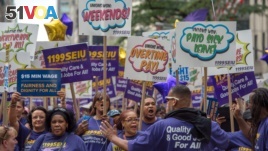September 7 is Labor Day in the United States. The national holiday began more than 100 years ago to honor low-paid factory workers.
Labor Day unofficially marks the end of summer. In any other year, students would be getting ready to go back to school. Many Americans would celebrate the day with an outdoor barbecue with family and friends. Others would use the long weekend to take their last vacation of the summer, before hot days turn cooler.

But 2020 is not any other year. Students in many parts of the country will be going back to school online for all or part of the autumn term. Health officials in several states are advising against social gatherings ahead of the holiday weekend. And travel — especially air travel — has been down sharply all summer.
Health officials have reason to be worried. Several parts of the country saw increases in COVID-19 cases following the other two major holidays this summer: Memorial Day and Independence Day. The increases in many places were linked to family gatherings.
Labor Day history
Labor Day started with a struggle. On May 1, 1889, workers demonstrated on the streets of Paris, France. International Labor Day was born. Most industrialized countries in the world — except the United States and Canada — celebrate Labor Day on the first of May.
The first American Labor Day celebration was held on September 5, 1882, in New York City. About 10,000 workers marched through the streets to show the strength of labor organizations.
For many years after that, American workers used the first Monday in September to demand better working conditions and pay. Music was a part of many of those marches.
Labor songs traditionally tell stories of conflict and hopes for a better life. Here is Pete Seeger’s “We Shall Not Be Moved.”
Many classic American labor songs came from workers in the coal mines of the South. Mine owners bitterly opposed workers’ unions. In Kentucky, company police searched for union leaders. They waited outside a worker’s home for several days to block him from organizing.
The coal miner’s wife, Florence Reece, stayed inside with her children. She wrote this song, “Which Side Are You On?” Here is Natalie Merchant singing the song.
Another American labor song is called “Bread and Roses.” It is based on a poem by James Oppenheim, published in December of 1911.
The poem speaks about the women’s labor movement. At that time, conditions in factories, where many women worked, were horrible. A fire at a clothing factory in New York killed 146 people. Most of the victims were immigrant women.
A month after Oppenheim’s poem was published, textile workers in Lawrence, Massachusetts went on strike. Their protest won them higher pay and better working conditions. Oppenheim’s poem gained more attention.
Here is Judy Collins singing “Bread and Roses.”
Even though Labor Day demonstrations are not as common in the U.S. today, the song reminds us to celebrate the effort and love that many people give to their work.
I’m Ashley Thompson.
Nancy Steinbach, Mario Ritter, Jerilyn Watson and Kelly Jean Kelly contributed to this report.